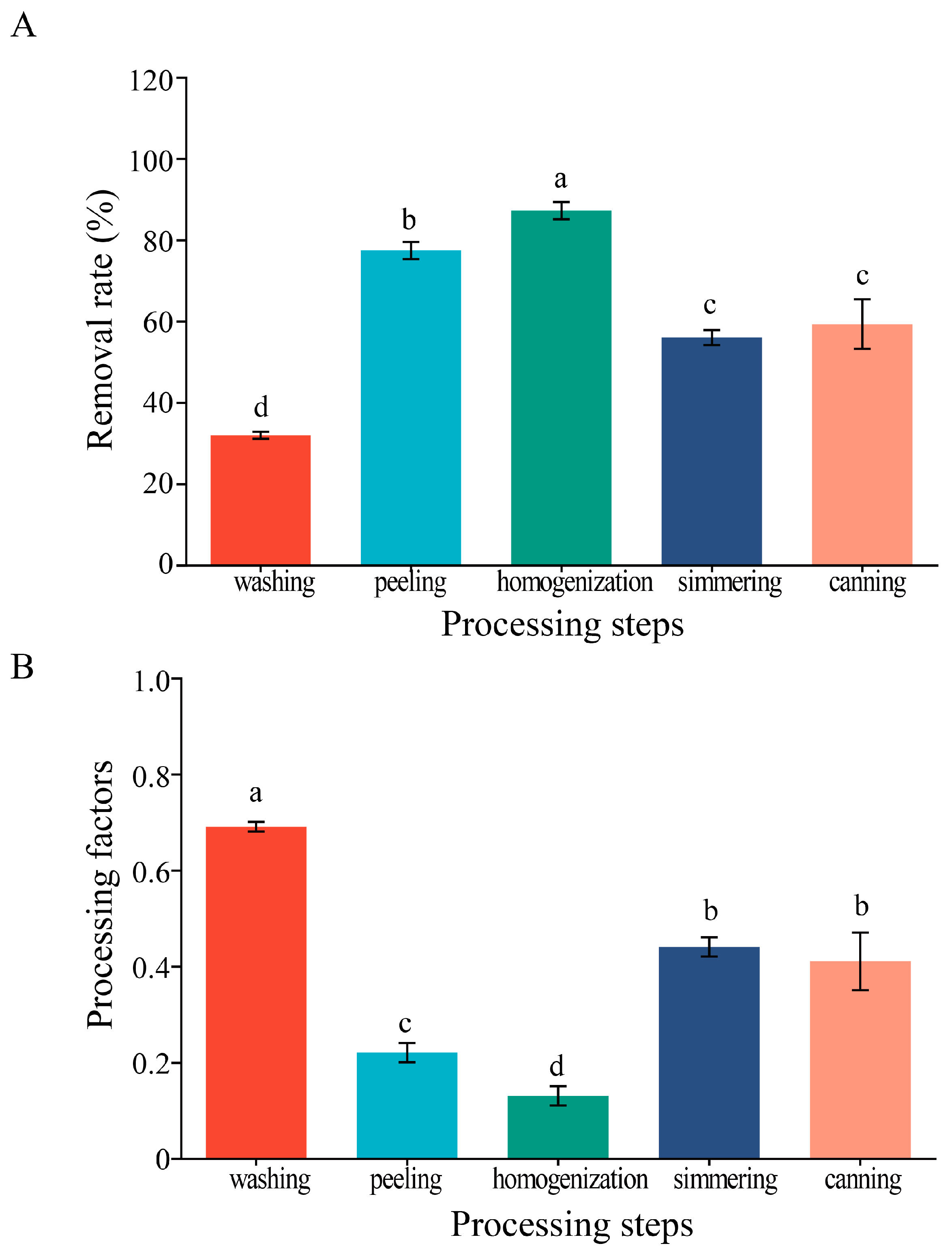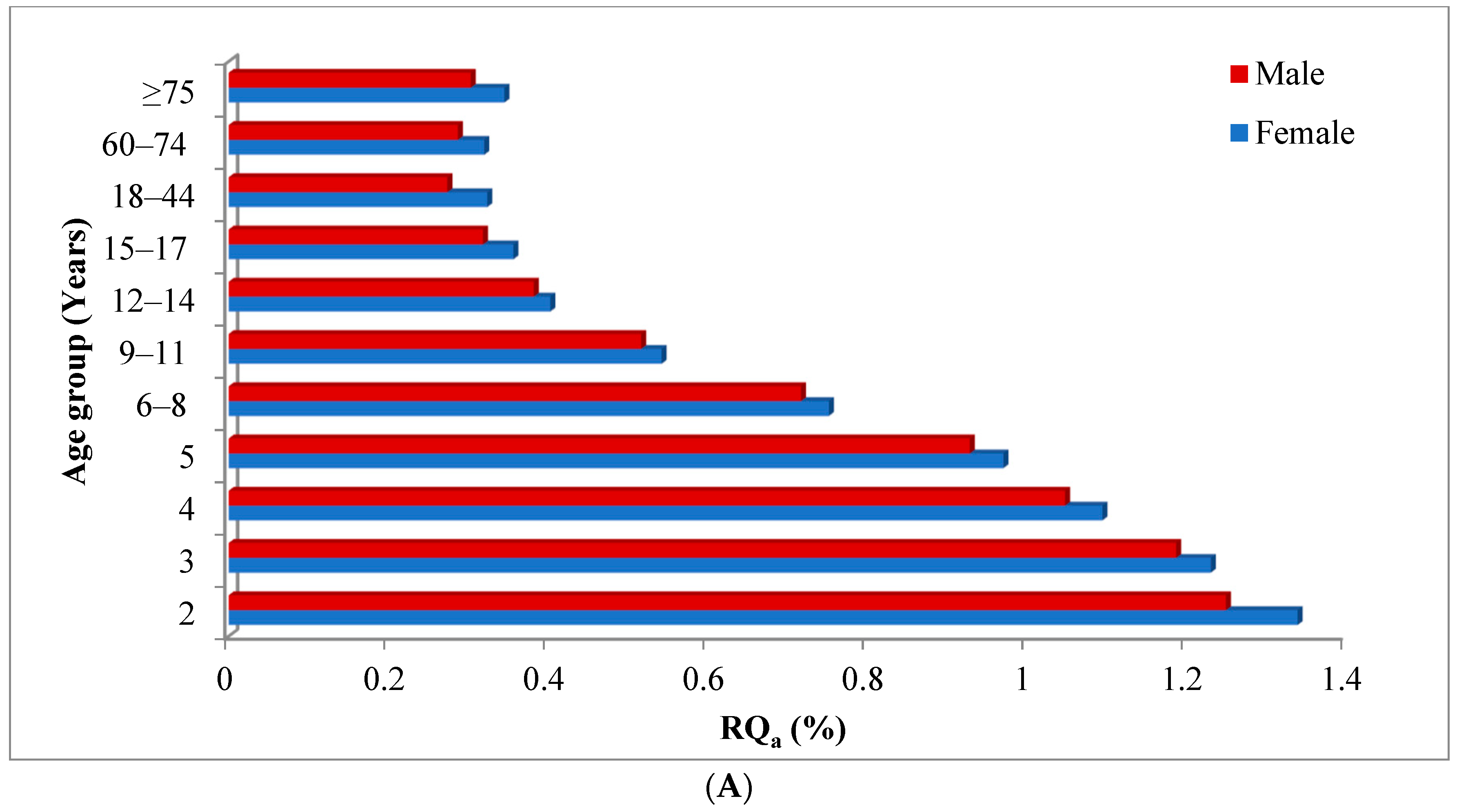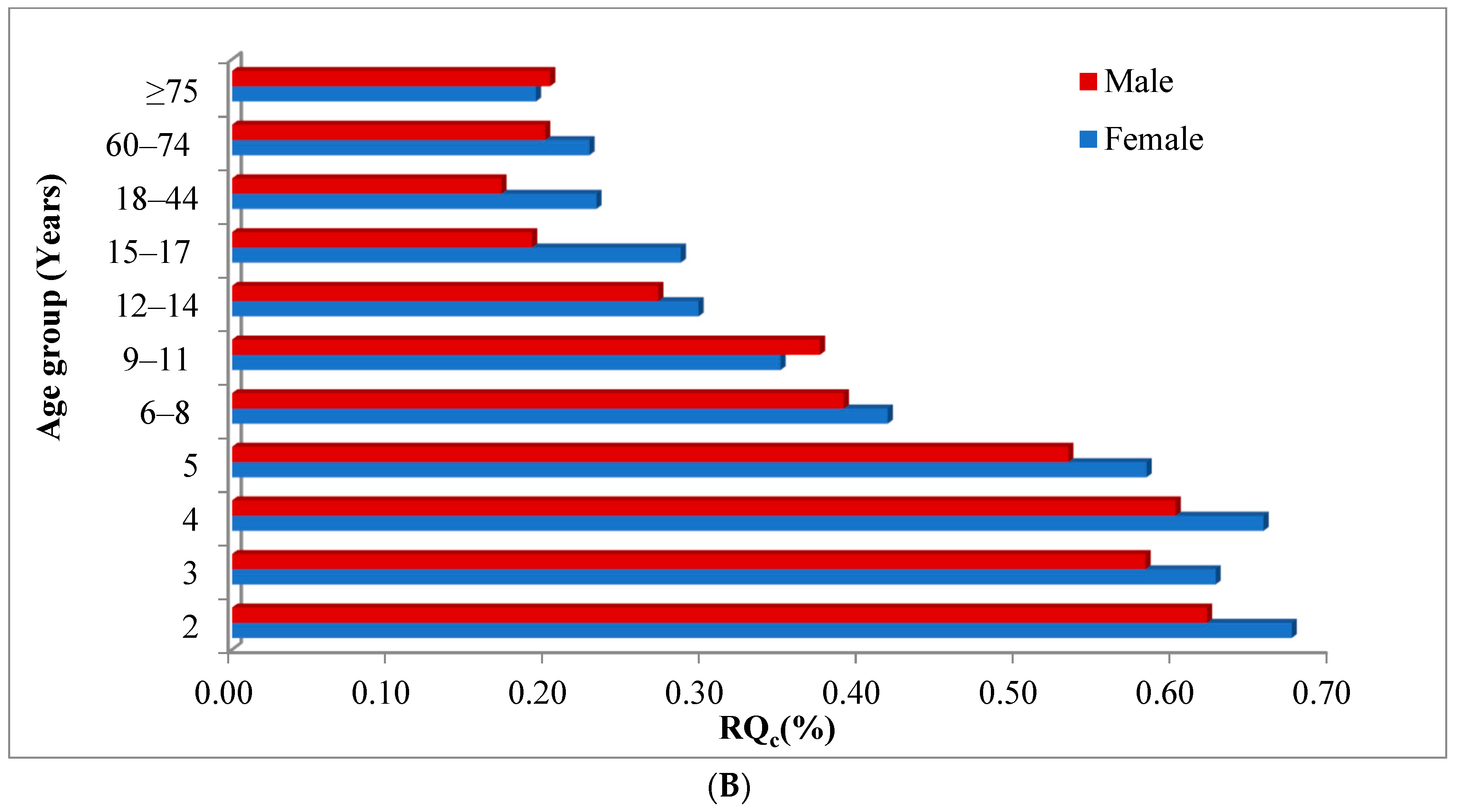Dissipation, Processing Factors and Dietary Exposure Assessment of Myclobutanil in Tomato
Abstract
:1. Introduction
2. Results and Discussion
2.1. Method Validation and Matrix Effect
2.2. The Dissipation of Myclobutanil in Tomato under Field Conditions
2.3. Effects of Tomato Processing on Residual Removal of Myclobutanil
2.4. Dietary Exposure Assessment of Myclobutanil in Tomato Processing
3. Materials and Methods
3.1. Chemicals and Reagents
3.2. Field Experiments and Sampling
3.3. Processing Treatments
3.4. Extraction and Cleaning of Samples
3.5. Instrument Analysis
3.6. Method Validation
3.7. Data Analysis
3.7.1. Dissipation Kinetics Analysis
3.7.2. PF Calculation
3.7.3. Acute (Short-Term) Intake Risk Assessment
3.7.4. Chronic (Long-Term) Intake Risk Assessment
3.7.5. Statistical Analysis
4. Conclusions
Author Contributions
Funding
Institutional Review Board Statement
Informed Consent Statement
Data Availability Statement
Conflicts of Interest
Sample Availability
References
- Bhowmik, D.; Kumar, K.P.S.; Paswan, S.; Srivastava, S. Tomato—A natural medicine and its health benefits. J. Pharmacogn. Phytochem. 2012, 1, 25–36. [Google Scholar]
- Clark, M.S.; Horwath, W.R.; Shennan, C.; Scow, K.M.; Lantni, W.T.; Ferris, H. Nitrogen, weeds and water as yield-limiting factors in conventional, low-input, and organic tomato systems. Agric. Ecosyst. Environ. 1999, 73, 257–270. [Google Scholar] [CrossRef]
- Nowicki, M.; Foolad, M.R.; Nowakowska, M.; Kozik, E.U. Potato and tomato late blight caused by Phytophthora infestans: An overview of pathology and resistance breeding. Plant Dis. 2012, 96, 4–17. [Google Scholar] [CrossRef] [PubMed] [Green Version]
- Abhary, M.; Patil, B.L.; Fauquet, C.M. Molecular biodiversity, taxonomy, and nomenculature of tomato yellow leaf curl-like viruses. In Tomato Yellow Leaf Curl Virus Disease; IntechOpen: Dordrecht, The Netherlands, 2007; pp. 85–118. [Google Scholar]
- Santana, P.A.; Kumar, L.; Da Silva, R.S.; Picanço, M.C. Global geographic distribution of Tuta absoluta as affected by climate change. J. Pest Sci. 2018, 92, 1373–1385. [Google Scholar] [CrossRef]
- Jankowska, M.; Kaczynski, P.; Hrynko, I.; Lozowicka, B. Dissipation of six fungicides in greenhouse-grown tomatoes with processing and health risk. Environ. Sci. Pollut. Res. 2016, 23, 11885–11900. [Google Scholar] [CrossRef] [PubMed] [Green Version]
- Hlihor, R.-M.; Pogăcean, M.O.; Rosca, M.; Cozma, P.; Gavrilescu, M. Modelling the behavior of pesticide residues in tomatoes and their associated long-term exposure risks. J. Environ. Manag. 2019, 233, 523–529. [Google Scholar] [CrossRef]
- Joint FAO/WHO Meeting on Pesticide Residues. Myclobutanil. 2014. Available online: https://www.fao.org/fileadmin/templates/agphome/documents/Pests_Pesticides/JMPR/Report2014/5.21_MYCLOBUTANIL__181_.pdf (accessed on 26 April 2022).
- Allen, J.W.; Wolf, D.C.; George, M.H.; Hester, S.D.; Sun, G.; Thai, S.-F.; Delker, D.A.; Moore, T.; Jones, C.; Nelson, G.; et al. Toxicity profiles in mice treated with hepatotumorigenic and non-hepatotumorigenic triazole conazole fungicides: Propiconazole, triadimefon, and myclobutanil. Toxicol. Pathol. 2006, 34, 853–862. [Google Scholar] [CrossRef]
- Sun, M.; Liu, D.; Qiu, X.; Zhou, Q.; Shen, Z.; Wang, P.; Zhou, Z. Acute toxicity, bioactivity, and enantioselective behavior with tissue distribution in rabbits of myclobutanil enantiomers. Chirality 2014, 26, 784–789. [Google Scholar] [CrossRef]
- Deng, Z.; Hu, J.; Qin, D.; Li, H. Simultaneous Analysis of Hexaconazole, Myclobutanil, and Tebuconazole Residues in Apples and Soil by SPE Clean-Up and GC with Nitrogen-Phosphorus Detection. Chromatographia 2010, 71, 679–684. [Google Scholar] [CrossRef]
- Hwang, J.-I.; Kim, J.-E. Residue patterns of fungicides, flusilazole and myclobutanil in apples. Curr. Res. Agric. Life Sci. 2013, 31, 272–279. [Google Scholar] [CrossRef]
- Wang, X.; Li, Y.; Xu, G.; Sun, H.; Xu, J.; Zheng, X.; Wang, F. Dissipation and Residues of Myclobutanil in Tobacco and Soil Under Field Conditions. Bull. Environ. Contam. Toxicol. 2012, 88, 759–763. [Google Scholar] [CrossRef] [PubMed]
- Abdallah, O.I.; Alrasheed, A.M.; Al-Mundarij, A.A.; Omar, A.F.; Alhewairini, S.S.; Al-Jamhan, K.A. Levels of residues and dietary risk assessment of the fungicides myclobutanil, penconazole, tebuconazole, and triadimenol in squash. Biomed. Chromatogr. 2021, 35, e5126. [Google Scholar] [CrossRef]
- Lou, Z.; Tang, F.; Luo, F.; Liu, G.; Chen, Z. Residue dynamics of myclobutanil in cucumber and soil. Agrochemicals 2008, 47, 205–207. [Google Scholar]
- Kaushik, G.; Satya, S.; Naik, S.N. Food processing a tool to pesticide residue dissipation—A review. Food Res. Int. 2009, 42, 26–40. [Google Scholar] [CrossRef]
- Li, M.; Liu, Y.; Fan, B.; Lu, J.; He, Y.; Kong, Z.; Zhu, Y.; Jian, Q.; Wang, F. A chemometric processing-factor-based approach to the determination of the fates of five pesticides during apple processing. LWT 2015, 63, 1102–1109. [Google Scholar] [CrossRef] [Green Version]
- Aguilera, A.; Valverde, A.; Camacho, F.; Boulaid, M.; Garcia-Fuentes, L. Household processing factors of acrinathrin, fipronil, kresoxim-methyl and pyridaben residues in green beans. Food Control 2014, 35, 146–152. [Google Scholar] [CrossRef]
- Wu, Y.; An, Q.; Li, D.; Wu, J.; Pan, C. Comparison of different home/commercial washing strategies for ten typical pesticide residue removal effects in kumquat, spinach and cucumber. Int. J. Environ. Res. Public Health 2019, 16, 472. [Google Scholar] [CrossRef] [PubMed] [Green Version]
- Saber, A.N.; Malhat, F.M.; Badawy, H.M.A.; Barakat, D.A. Dissipation dynamic, residue distribution and processing factor of hexythiazox in strawberry fruits under open field condition. Food Chem. 2016, 196, 1108–1116. [Google Scholar] [CrossRef] [PubMed]
- Bian, Y.; Feng, Y.; Zhang, A.; Qi, X.; Ma, X.; Pan, J.; Han, J.; Liang, L. Residue behaviors, processing factors and transfer rates of pesticides and metabolites in rose from cultivation to consumption. J. Hazard. Mater. 2023, 442, 130104. [Google Scholar] [CrossRef]
- Xiao, O.; Li, M.; Chen, D.; Chen, J.; Simal-Gandara, J.; Dai, X.; Kong, Z. The dissipation, processing factors, metabolites, and risk assessment of pesticides in honeysuckle from field to table. J. Hazard. Mater. 2022, 431, 128519. [Google Scholar] [CrossRef]
- Chambers, E.; Wagrowski-Diehl, D.M.; Lu, Z.; Mazzeo, J.R. Systematic and comprehensive strategy for reducing matrix effects in LC/MS/MS analyses. J. Chromatogr. B Anal. Technol. Biomed. Life 2007, 852, 22–34. [Google Scholar] [CrossRef] [PubMed]
- Huang, Y.; Cheng, M.; Li, W.; Wu, L.; Chen, Y.; Luo, Y.; Christie, P.; Zhang, H. Simultaneous extraction of four classes of antibiotics in soil, manure and sewage sludge and analysis by liquid chromatography-tandem mass spectrometry with the isotope-labelled internal standard method. Anal. Methods 2013, 5, 3721–3731. [Google Scholar] [CrossRef]
- Matuszewski, B.K.; Constanzer, M.L.; Chavez-Eng, C.M. Strategies for the Assessment of Matrix Effect in Quantitative Bioanalytical Methods Based on HPLC-MS/MS. Anal. Chem. 2003, 75, 3019–3030. [Google Scholar] [CrossRef] [PubMed]
- Suchi, C.; Patel, H.K.; Gor, H.N.; Vaghela, K.M.; Solanki, P.P.; Shah, P.G. Evaluation of Matrix Effects in Multiresidue Analysis of Pesticide Residues in Vegetables and Spices by LC-MS/MS. J. AOAC Int. 2007, 100, 616–623. [Google Scholar]
- Kmellár, B.; Fodor, P.; Pareja, L.; Ferrer, C.; Martínez-Uroz, M.A.; Valverde, A.; Fernandez-Alba, A.R. Validation and uncertainty study of a comprehensive list of 160 pesticide residues in multi-class vegetables by liquid chromatography–tandem mass spectrometry. J. Chromatogr. A 2008, 1215, 37–50. [Google Scholar] [CrossRef]
- Liu, X.; Dong, F.; Wang, X.; Zheng, Y. The dissipation rates of myclobutanil and residue analysis in wheat and soil using gas chromatography-ion trap mass spectrometry. Int. J. Environ. Anal. Chem. 2009, 89, 957–967. [Google Scholar] [CrossRef]
- Liu, Y.; Sun, H.; Liu, F.; Wang, S. Dissipation and residue of myclobutanil in lychee. Bull. Environ. Contam. Toxicol. 2012, 88, 902–905. [Google Scholar] [CrossRef]
- Li, Y.; Jiao, B.; Zhao, Q.; Wang, C.; Gong, Y.; Zhang, Y.; Chen, W. Effect of commercial processing on pesticide residues in orange products. Eur. Food Res. Technol. 2012, 234, 449–456. [Google Scholar] [CrossRef]
- Yang, T.; Doherty, J.; Zhao, B.; Kinchla, A.J.; Clark, J.M.; He, L. Effectiveness of Commercial and Homemade Washing Agents in Removing Pesticide Residues on and in Apples. J. Agric. Food Chem. 2017, 65, 9744–9752. [Google Scholar] [CrossRef]
- Reiler, E.; Jors, E.; Baelum, J.; Huici, O.; Alvarez Caero, M.M.; Cedergreen, N. The influence of tomato processing on residues of organochlorine and organophosphate insecticides and their associated dietary risk. Sci. Total Environ. 2015, 527–528, 262–269. [Google Scholar] [CrossRef]
- Kwon, H.; Kim, T.-K.; Hong, S.-M.; Se, E.-K.; Cho, N.-J.; Kyung, K.-S. Effect of household processing on pesticide residues in field-sprayed tomatoes. Food Sci. Biotechnol. 2015, 24, 1–6. [Google Scholar] [CrossRef]
- Chen, Z.; Dong, F.; Ren, X.; Wu, X.; Yuan, L.; Li, L.; Li, W.; Zheng, Y. Enantioselective fate of dinotefuran from tomato cultivation to home canning for refining dietary exposure. J. Hazard. Mater. 2021, 405, 124254. [Google Scholar] [CrossRef] [PubMed]
- Kontou, S.; Tsipi, D.; Tzia, C. Stability of the dithiocarbamate pesticide maneb in tomato homogenates during cold storage and thermal processing. Food Addit. Contam. 2004, 21, 1083–1089. [Google Scholar] [CrossRef] [PubMed]
- GB 2763-2021; National Food Safety Standard Maximum Residue Limits for Pesticides in Food. Ministry of Agriculture and Rural Affairs of the People’s Republic of China: Beijing, China, 2021. Available online: https://www.sdtdata.com/fx/fmoa/tsLibCard/183688.html (accessed on 20 March 2022).
- US MRL. Code of Federal Regulations, PART 180—Tolerances and Exemptions for Pesticide Chemical Residues in Food. Available online: https://www.ecfr.gov/current/title-40/chapter-I/subchapter-E/part-180 (accessed on 3 February 2022).
- Yang, Y.; Qin, S.; Wang, X.; Cao, J.; Li, J. Dissipation Behavior and Acute Dietary Risk Assessment of Thiamethoxam and Its Metabolite Clothianidin on Spinach. Molecules 2022, 27, 2209. [Google Scholar] [CrossRef]
- Yang, G.; Li, J.; Lan, T.; Dou, L.; Zhang, K. Dissipation, residue, stereoselectivity and dietary risk assessment of penthiopyrad and metabolite PAM on cucumber and tomato in greenhouse and field. Food Chem. 2022, 387, 132875. [Google Scholar] [CrossRef] [PubMed]
- Cámara, M.A.; Cermeño, S.; Martínez, G.; Oliva, J. Removal residues of pesticides in apricot, peach and orange processed and dietary exposure assessment. Food Chem. 2020, 325, 126936. [Google Scholar] [CrossRef]
- Jankowska, M.; Łozowicka, B. The processing factors of canning and pasteurization for the most frequently occurring fungicides and insecticides in apples and their application into dietary risk assessment. Food Chem. 2022, 371, 131179. [Google Scholar] [CrossRef]
- Zhu, X.; Jia, C.; Duan, L.; Zhang, W.; Yu, P.; He, M.; Chen, L.; Zhao, E. Residue behavior and dietary intake risk assessment of three fungicides in tomatoes (Lycopersicon esculentum Mill.) under greenhouse conditions. Regul. Toxicol. Pharmacol. 2016, 81, 284–287. [Google Scholar] [CrossRef]
- Jensen, B.H.; Petersen, A.; Nielsen, E.; Christensen, T.; Poulsen, M.E.; Andersen, J.H. Cumulative dietary exposure of the population of Denmark to pesticides. Food Chem. Toxicol. 2015, 83, 300–307. [Google Scholar] [CrossRef]
- Lehmann, E.; Turrero, N.; Kolia, M.; Konaté, Y.; de Alencastro, L.F. Dietary risk assessment of pesticides from vegetables and drinking water in gardening areas in Burkina Faso. Sci. Total Environ. 2017, 601–602, 1208–1216. [Google Scholar] [CrossRef]
- Steven, J.L. Determination of pesticide residues in foods by acetonitrile extraction and partitioning with magnesium sulfate: Collaborative study. J. AOAC Int. 2007, 90, 485–520. [Google Scholar]
- Michelangelo, A.; Steven, J.L. Fast and easy multiresidue method employing acetonitrile extraction/partitioning and “dispersive solid-phase extraction” for the determination of pesticide residues in produce. J. AOAC Int. 2003, 86, 412–431. [Google Scholar]
- Method Validation Procedures for Pesticide Residues and Analysis in Food and Feed. N. SANTE 11312/2021. Available online: https://ec.europa.eu/food/system/files/2022-02/pesticides_mrl_guidelines_wrkdoc_2021-11312.pdf (accessed on 5 March 2021).
- Hassan, H.; Elsayed, E.; El-Raouf, A.E.-R.A.; Salman, S.N. Method validation and evaluation of household processing on reduction of pesticide residues in tomato. J. Consum. Prot. Food Saf. 2019, 14, 31–39. [Google Scholar] [CrossRef]
- Jing, D.; Zheng, C.; Bi, J.; Xu, Y. Residue behavior of organochlorine pesticides during the production process of yogurt and cheese. Food Chem. 2017, 245, 119–124. [Google Scholar]
- Food and Agriculture Organization of the United Nations (FAO); World Health Organization (WHO). Guidance for International Estimated Short-Term Intake (IESTI). Available online: https://cdn.who.int/media/docs/default-source/food-safety/gemsfood/guidance-iesti-2014.pdf?sfvrsn=9b24629a_2 (accessed on 3 January 2022).
- World Health Organization (WHO). Guidelines for Predicting Dietary Intake of Pesticide Residues. (IEDI). Available online: https://www.who.int/publications/i/item/WHO_FSF_FOS_97.7 (accessed on 3 January 2022).





| Matrix | Spiked Levels (mg/kg) | Average Recovery (%) | RSD (%) |
|---|---|---|---|
| Tomato | 0.01 | 96 | 1.5 |
| 0.1 | 92 | 1.9 | |
| 0.5 | 93 | 2.1 | |
| Tomato juice | 0.01 | 97 | 1.8 |
| 0.1 | 96 | 1.8 | |
| 0.5 | 94 | 2.5 | |
| Tomato seed | 0.01 | 102 | 9.1 |
| 0.1 | 94 | 1.2 | |
| 0.5 | 82 | 6.7 |
| Sample | Concentration ± SD (mg/kg) |
|---|---|
| Raw tomato | 0.100 ± 0.009 |
| Washed whole tomato | 0.067 ± 0.024 |
| Tomato skin | 0.395 ± 0.052 |
| Tomato pulp | 0.023 ± 0.001 |
| Tomato puree | 0.013 ± 0.001 |
| Tomato juice | 0.009 ± 0.001 |
| Tomato seeds | 0.027 ± 0.009 |
| Tomato paste | 0.044 ± 0.003 |
| Canned tomato paste | 0.041 ± 0.006 |
| Age Group | Gender | BW (kg) | Consumers P97.5 (g/d) | IESTI μg/(kg bw d) | RQa% | Dietary Consumption (kg) | IEDI mg/d | Acceptable Daily Intake mg/d | RQc % | ||||
|---|---|---|---|---|---|---|---|---|---|---|---|---|---|
| Flour and Its Products | Other Grains | Light Vegetables | Citrus | Dark Vegetables | |||||||||
| 2 years | Female | 14.2 | 15.8654 | 4.0142 | 1.34 | 0.0577 | 0.0079 | 0.0353 | 0.0449 | 0.0381 | 0.2877 | 0.4260 | 0.68 |
| Male | 14.8 | 7.3099 | 3.6930 | 1.23 | 0.0589 | 0.0093 | 0.0309 | 0.0491 | 0.0340 | 0.2759 | 0.4440 | 0.62 | |
| 3 years | Female | 15.3 | 12.6582 | 3.2850 | 1.10 | 0.0577 | 0.0079 | 0.0353 | 0.0449 | 0.0381 | 0.2877 | 0.4590 | 0.63 |
| Male | 15.8 | 11.2613 | 2.9125 | 0.97 | 0.0589 | 0.0093 | 0.0309 | 0.0491 | 0.0340 | 0.2759 | 0.4740 | 0.58 | |
| 4 years | Female | 17.2 | 12.6582 | 2.2563 | 0.75 | 0.0769 | 0.0079 | 0.0429 | 0.0715 | 0.0372 | 0.3392 | 0.5160 | 0.66 |
| Male | 17.9 | 11.2613 | 1.6277 | 0.54 | 0.0821 | 0.0092 | 0.0458 | 0.0755 | 0.0322 | 0.3229 | 0.5370 | 0.60 | |
| 5 years | Female | 19.4 | 12.6582 | 1.2092 | 0.40 | 0.0769 | 0.0079 | 0.0429 | 0.0715 | 0.0372 | 0.3392 | 0.5820 | 0.58 |
| Male | 20.2 | 11.2613 | 1.0704 | 0.36 | 0.0821 | 0.0092 | 0.0458 | 0.0755 | 0.0322 | 0.3229 | 0.6060 | 0.53 | |
| 6–8 years | Female | 24.6 | 6.2500 | 0.9722 | 0.32 | 0.0906 | 0.0103 | 0.0880 | 0.0477 | 0.0404 | 0.3082 | 0.7380 | 0.42 |
| Male | 25.8 | 6.2101 | 0.9607 | 0.32 | 0.1041 | 0.0116 | 0.0955 | 0.0509 | 0.0375 | 0.3016 | 0.7740 | 0.39 | |
| 9–11 years | Female | 34.1 | 6.2500 | 1.0367 | 0.35 | 0.1034 | 0.0125 | 0.1072 | 0.0545 | 0.0472 | 0.3574 | 1.0230 | 0.35 |
| Male | 35.8 | 6.2101 | 3.7614 | 1.25 | 0.1218 | 0.0126 | 0.1140 | 0.0577 | 0.0545 | 0.4022 | 1.0740 | 0.37 | |
| 12–14 years | Female | 45.9 | 6.2500 | 3.5623 | 1.19 | 0.1285 | 0.0115 | 0.1201 | 0.0645 | 0.0530 | 0.4092 | 1.3770 | 0.30 |
| Male | 48.4 | 6.2101 | 3.1444 | 1.05 | 0.1438 | 0.0141 | 0.1258 | 0.0652 | 0.0494 | 0.3942 | 1.4520 | 0.27 | |
| 15–17 years | Female | 51.5 | 3.8251 | 2.7864 | 0.93 | 0.1317 | 0.0117 | 0.1312 | 0.0749 | 0.0552 | 0.4417 | 1.5450 | 0.29 |
| Male | 57.6 | 3.4671 | 2.1511 | 0.72 | 0.1910 | 0.0168 | 0.1443 | 0.0700 | 0.0337 | 0.3302 | 1.7280 | 0.19 | |
| 18–44 years | Female | 56.7 | 3.8251 | 1.5502 | 0.52 | 0.1268 | 0.0129 | 0.1592 | 0.0821 | 0.0430 | 0.3948 | 1.7010 | 0.23 |
| Male | 67.0 | 3.4671 | 1.1466 | 0.38 | 0.1569 | 0.0123 | 0.1750 | 0.0845 | 0.0314 | 0.3447 | 2.0100 | 0.17 | |
| 60–74 years | Female | 57.3 | 3.3093 | 0.9561 | 0.32 | 0.1168 | 0.0196 | 0.1621 | 0.0810 | 0.0429 | 0.3912 | 1.7190 | 0.23 |
| Male | 63.9 | 3.2401 | 0.8219 | 0.27 | 0.1373 | 0.0193 | 0.1778 | 0.0862 | 0.0386 | 0.3823 | 1.9170 | 0.20 | |
| ≥75 years | Female | 53.0 | 2.6508 | 0.8613 | 0.29 | 0.0905 | 0.0152 | 0.1294 | 0.0718 | 0.0305 | 0.3078 | 1.5900 | 0.19 |
| Male | 60.5 | 3.3273 | 0.9099 | 0.30 | 0.1126 | 0.1590 | 0.1574 | 0.0843 | 0.0364 | 0.3678 | 1.8150 | 0.20 | |
Disclaimer/Publisher’s Note: The statements, opinions and data contained in all publications are solely those of the individual author(s) and contributor(s) and not of MDPI and/or the editor(s). MDPI and/or the editor(s) disclaim responsibility for any injury to people or property resulting from any ideas, methods, instructions or products referred to in the content. |
© 2023 by the authors. Licensee MDPI, Basel, Switzerland. This article is an open access article distributed under the terms and conditions of the Creative Commons Attribution (CC BY) license (https://creativecommons.org/licenses/by/4.0/).
Share and Cite
Qi, Y.; Cao, J.; Li, C.; Ren, P.; Qin, S.; Li, J. Dissipation, Processing Factors and Dietary Exposure Assessment of Myclobutanil in Tomato. Molecules 2023, 28, 5978. https://doi.org/10.3390/molecules28165978
Qi Y, Cao J, Li C, Ren P, Qin S, Li J. Dissipation, Processing Factors and Dietary Exposure Assessment of Myclobutanil in Tomato. Molecules. 2023; 28(16):5978. https://doi.org/10.3390/molecules28165978
Chicago/Turabian StyleQi, Yanli, Junli Cao, Chunyong Li, Pengcheng Ren, Shu Qin, and Jindong Li. 2023. "Dissipation, Processing Factors and Dietary Exposure Assessment of Myclobutanil in Tomato" Molecules 28, no. 16: 5978. https://doi.org/10.3390/molecules28165978







